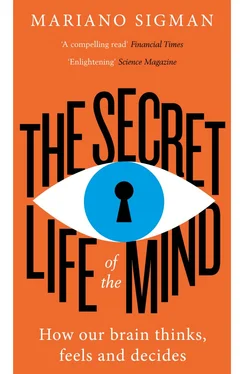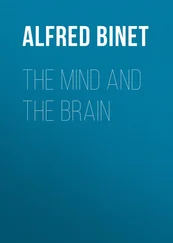1 ...6 7 8 10 11 12 ...16 Six-month-old infants, before crawling, walking or talking, when they are barely discovering how to sit up and eat with a spoon, are already able to infer intentions, desires, kindness and evil, as can be deduced from examining their choices and gestures.
The construction of morality is, of course, much more sophisticated. We cannot judge a person to be good or bad just by knowing they did something helpful. For example, helping a thief is usually considered ignoble. Would the babies prefer someone who helps a thief to someone who thwarts one? We are now in the murky waters that are the origins of morality and law. But even in this sea of confusion, babies between nine months and a year of age already have an established opinion.
The experiment that proves it goes like this. Babies see a hand puppet trying to lift the top off a box in order to pull out a toy. Then a helpful puppet shows up and helps it open the lid and get the toy. But in another scene an anti-social puppet jumps maliciously on to the box, slamming it shut and keeping the first puppet from getting at the toy. When choosing between the two puppets, the babies prefer the helper. But here Wynn was going for something much more interesting: identifying what the babies think about stealing from an evildoer, long before they know those words.
To do this she designed a third act for the puppet theatre, and the helper puppet now loses a ball. In some cases, in this garden of forking paths, a new character appears on the scene and returns the ball. At other times, another character comes in, steals it and runs away. The babies prefer the character that returns the ball.
But the most interesting and mysterious part happens when these scenes feature the antisocial puppet that jumped maliciously on the box. In this case, the babies change their preference. They sympathize with the one who steals the ball and runs away. For nine-month-olds, the one who gives the bad guy his comeuppance is more lovable than the one who helps him, at least in that world of puppets, boxes and balls. fn11
Preverbal babies, still unable to coordinate their hands in order to grab an object, do something much more sophisticated than judging others by their actions. They take into account the contexts and the history, which turns out to give them a pretty sophisticated notion of justice. That’s how incredibly disproportionate cognitive faculties are during the early development of a human being.
The colour of a jersey, strawberry or chocolate
We adults are not unbiased when we judge others. Not only do we keep in mind their previous history and the context of their actions (which we should), but we also have very different opinions of the person committing the actions, or being the victim of them, if they look like us or not (which we shouldn’t).
Throughout all cultures, we tend to form more friendships and have more empathy with those who look like us. On the other hand, we usually judge more harshly and show more indifference to the suffering of those who are different. History is filled with instances in which human groups have massively supported or, in the best-case scenario, rejected violence directed at individuals who were not like them.
This even manifests itself in formal justice proceedings. Some judges serve sentences displaying a racial bias, most probably without being aware that race is influencing their judgement. In the United States, African American males have been incarcerated at about six times the rate of white males. Is this difference in the incarceration rate a result (at least in part) of the judges having different sentencing practices? This seemingly simple and direct question turns out to be hard to answer because it is difficult to separate this psychological factor from possible racial differences in case characteristics. To overcome this problem Sendhil Mullainathan, Professor of Economics at Harvard University, found an ingenious solution, exploiting the fact that in the United States cases are randomly assigned to judges. Hence, on average, the type of case and the nature of defendants are the same for all judges. A racial difference in sentencing could potentially be explained by case characteristics or by a difference in the quality of the assigned attorneys (which is not random). But if this were all, then this difference should be the same for all judges. Instead, Mullainathan found a huge disparity – of almost 20 per cent – between judges in the racial gap in sentencing. While this may be the most convincing demonstration that race matters in the courtroom, the method is partly limited since it cannot tell whether the variability between judges’ results is due to some of them discriminating against African Americans, or some judges discriminating against whites, or a mixture of both.
Physical appearance also affects whether someone is likely to be hired in a job interview. Since the early seventies, several studies have shown that attractive applicants are typically judged to have a more appropriate personality for a job, and to perform better than their less attractive counterparts. Of course, this was not just a matter of comment. Applicants who were judged to be more attractive were also more likely to be hired. As we will see in Chapter 5, we all tend to make retrospective explanations that serve to justify our choices. Hence the most likely timeline for this line of argument is like this: first the interviewer decides to hire the applicant (among other things based on his or her beauty) and only then generates ad hoc a long list of attributes (he or she was more capable, more suited for the job, more reliable …) that serve to justify the choice which indeed had nothing to do with these considerations.
The similarities that generate these predispositions can be based on physical appearance, but also on religious, cultural, ethnic, political or even sports-related questions. This last example, because it is presumed to be more harmless – although, as we know, even sporting differences can have dramatic consequences – is easier to assimilate and recognize. Someone forms part of a consortium, a club, a country, a continent. That person suffers and celebrates collectively with that consortium. Pleasure and pain are synchronized between thousands of people whose only similarity is belonging to a tribe (sharing a jersey, a neighbourhood or a history) that unites them. But there is something more: pleasure at the suffering of other tribes. Brazil celebrates Argentina’s defeats, and Argentina celebrates Brazil’s. A fan of Liverpool cheers for the goal scored against Manchester United. When rooting for our favourite sports teams, we often feel less inhibited about expressing Schadenfreude , our pleasure at the suffering of those unlike us.
What are the origins of this? One possibility is that it has ancestral evolutionary roots, that the drive collectively to defend what belonged to one’s tribe was advantageous at some point in human history and, as a result, adaptive. This is merely conjecture but it has a precise, observable footprint that can be traced. If Schadenfreude is a constituent aspect of our brains (the product of a slow learning process within evolutionary history), it should manifest itself early in our lives, long before we establish our political, sports or religious affiliations. And that is exactly how it happens.
Wynn performed an experiment to ask whether infants prefer those who help or harm dissimilar persons. This experiment was also carried out in a puppet theatre. Before entering the theatre, a baby between nine and fourteen months old, seated comfortably on their mother’s lap, chose between crackers or green beans. Apparently, food choices reveal tendencies and strong allegiances.
Читать дальше












